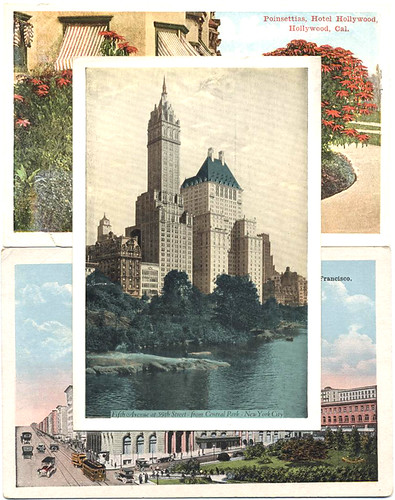The Cooper Hewitt National Design Museum Library boasts more than 10,000 postcards in its “hidden” collection. Arranged by subject in card file drawers, they range in date from the turn of the century to the 1990’s. In our last post, the history of postcards was featured. In this fourth and final post, the Libraries will feature different types of postcards.
Postcards are typically broken into eight eras:
Pioneer Era (Pre-1898) In the early years of the postcard, only the address could be printed on the back; any messages would have to be scrawled around the picture on the front. Those printed before 1898 were known as the Pioneer Era, and are characterized by an undivided back with lines printed on the back for the name of the addressee and his or her address.
Private Mailing Card Era (1898-1901) In the United States, on May 19, 1898, Congress granted private printers permission to print their own postcards, but they were required to inscribe “Private Mailing Card” on the top of the card (Previously, postcards had to be government issued). This era is called the Private Mailing Card Era, ranging from May 19, 1898 to December 24, 1901.
Undivided Back Postcard Era (1901-1907) The Undivided Back “Postcard” era followed, lasting from December 24, 1901 until March 1, 1907. The message was still restricted to the side with the picture, but publishers no longer printed “Private Mailing Card” but instead “Postcard” on the top of their cards.
Divided Back Era – Golden Age of Postcards (1907-1915) Messages were finally allowed on the backs of postcards on March 1st, 1907. This era, known as the Divided Back Era as well as the “Golden Age” of postcards, lasted from 1907 until 1915, the advent of World War I.
White Border Era (1915-1930) The German publishing industry was severely impacted by the war, and the United States introduced high tariff rates that drive European publishers out of the American market. Cards published in the United States included a white border around the image to save money on ink, and thus, this period is called the White Border Era.
Linen Era (1930-1945) Advancements in printing technology allowed publishers to print on paper with a high rag content, or texture. These cards were cheap to produce and allowed publishers to experiment with bright colors.
Photochrome Era (1939-1970) With new printing technology publishers were finally able to print photographic color images on glossy paper. Printed from color film, the cards were finally coating in varnish, giving them an attractive sheen.
Continental Period (1970-present) During the 1970’s in the United States, postcard dimensions were enlarged from 3 ½ by 5 ½ inches to 4 by 6 inches. While new in America, this size had been standard in Europe since the 1920’s.
We hope you have enjoyed this survey of postcards.Check out the Libraries flickr site for additional images.—Sara O'Keeffe




5 Comments
I never knew that there was a difference, learn
My grandpa has a TON of saved post cards. A lot he brought back from Germany in WWII.
hii
Where can I find information about Iceland postcards?
Like various types?
Startled to see several grammatical errors, including mismatching tense as in the following: “the United States introduced high tariff rates that drive European publishers out of the American market.” ICYMI, “drive” should be “drove” in this sentence.
Other problems: I see 8 periods of postcard production and only three illustrations. I see no backs of any cards.
I see no description of “real photo” postcards.
It would be nice to have a blog post describing the process by which postcards are scanned and accessioned for inclusion in the Smithsonian collection.